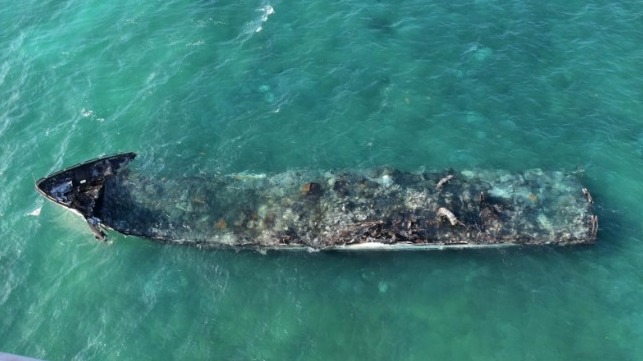NTSB: Lack of Fire Dampers May Have Hindered Response to Yacht Fire

The runaway fire aboard the motor yacht La Dolce Vita off Key West last year was likely caused by an electrical fire in the engine room, according to the NTSB. Once started, the engine room fire could not be extinguished - in part because the space had no fire dampers or provisions for remote shutdown of the ventilation fans.
La Dolce Vita was a 100-foot Hargrave raised pilot house yacht built in 2009. On the evening of March 16, 2021, the chief mate aboard the yacht smelled something burning and discovered smoke in the engine room, emating from the enclosure on the starboard generator set. He shut the hatch and went to get the captain. They returned together, and when they opened the door, they saw flames and smoke billowing from the generator.
The captain secured both generators and attempted to use fire extinguishers to put out the blaze. Seeing that they had no effect, he shut the hatch again and - without taking further preparatory steps - activated the fixed-firefighting system, releasing FM-200 fire suppression gas into the space.
He then proceeded to make a distress call to the U.S. Coast Guard over VHF, and he ordered the passengers to get ready to evacuate. After making one last attempt to put out the fire with a fire extinguisher, he abandoned ship in the yacht tender with the passengers and other crewmembers. A Coast Guard fast response boat out of Key West arrived shortly after and safely rescued all survivors.

La Dolce Vita's fiberglass-composite structure combusts, March 16, 2021 (NTSB)
La Dolce Vita burned to the waterline, as is common in major fires aboard fiberglass-composite craft, then sank to the bottom in a designated National Marine Sanctuary. The vessel was declared a total loss at a cost of about $3.9 million. The wreck was salvaged and carried a shore for inspection, but due to the extent of the damage, it was not possible to determine the root cause of the fire with certainty.
However, investigators were able to determine that the crew had little chance of securing ventilation to the engine room. The space was fitted with two intake fans and two exhaust fans, which could only be switched on and off at the main switchboard at the forward end of the engine room. Even if these were shut off, the space had no fire dampers, as they were not required by the applicable yacht standards at the time of the vessel's construction and had not been retrofitted later.
"Fixed fire-extinguishing systems in machinery and other hazardous spaces require a minimum concentration of extinguishing agent to either halt the chemical reaction producing the fire, displace the oxygen feeding the fire, or effect a combination of both," noted NTSB. "To ensure the effectiveness of the system and prevent the reintroduction of oxygen to the space, vessel designers and owners should ensure that the ventilation, both natural and forced draft, can be completely and remotely secured."
